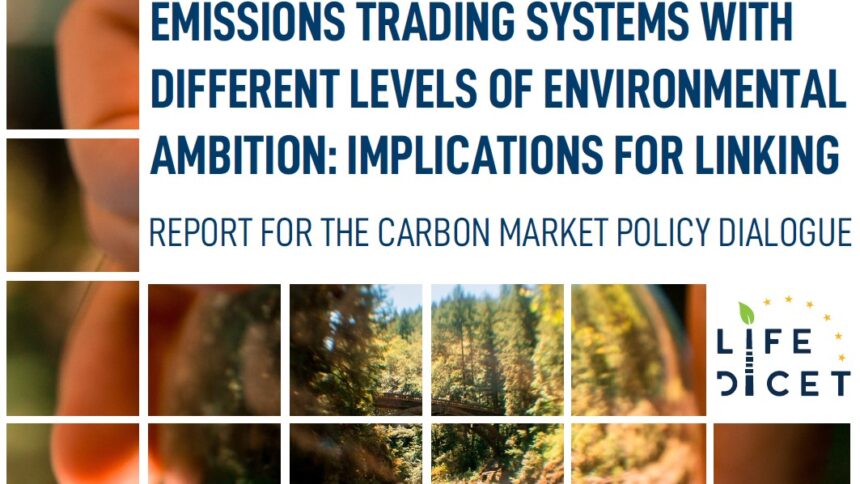A post by Albert Ferrari
The report “Emissions Trading Schemes with different levels of environmental ambition: implications for linking – Report for the Carbon Market Policy Dialogue“ published in November 2020 is one of the main outputs of the project LIFE DICET.
This report was prepared to inform the Carbon Market Policy Dialogue (CMPD) between the European Commission, as the regulator of the EU Emissions Trading System, and the regulatory authorities for the emissions trading systems (ETSs) of California, Québec, China, New Zealand, and Switzerland. The report deals with the implications of linking ETSs that differ from each other in the level of environmental ambition. It provides a conceptual framework and summarises the relevant scientific literature; it describes the current status of the six ETSs represented in the CMPD and, finally, it offers up a few ideas for discussion.
In the report, the environmental ambition of an ETS is conceptualised through three dimensions:
- The ‘emissions coverage’ of an ETS is the share of a jurisdiction’s total emissions that is regulated;
- The ‘stringency’ of an ETS refers to its targeted abatement level at a certain point in time or over a certain time period with respect to Business as Usual (BAU) emissions. Allowance prices are an imperfect metric for the stringency of an ETS. Yet, arguably, they are the best proxy for ETS stringency;
- The ‘determinacy’ is the quality of an abatement target to ensure emissions remain below a certain level irrespective of economic activity (absolute-cap ETS) or, conversely, to accommodate lower or higher emissions depending on the economy’s evolution (relative-cap ETS).
According to the report’s literature, differences in marginal compliance costs between ETSs provide the main economic rationale for their linking, namely, reducing the cost of total abatement, usually to the benefit of both jurisdictions. However, different outcomes are possible depending on specificities of the given ETSs and the type of linkage.
A range of economic and political factors can diminish a jurisdiction’s willingness or ability to link. Notably, two distributional effects need to be considered when linking ETSs with different levels of environmental ambition: the revenue transfer between jurisdictions, and winners and losers among regulated entities within each jurisdiction. Moreover, linking implies a partial loss of political control over the ETS and its associated carbon price.
The authors of the report assess the level of environmental ambition of the ETSs in the CMPD and discuss their compatibility for potential linking. In this regard, the authors note that an interesting future linking project could involve the ETSs of California and Quebec (linked together since 2014), on the one hand, and the ETSs of Switzerland and EU (linked since 2020), on the other. Conversely, linkages between absolute- and relative-cap ETSs, such as China’s forthcoming ETS, are problematic in that overall emissions could increase as a result.
The report also highlights that linking agreement should stipulate the future emission reduction targets of the ETSs, and limit the possibility of unilateral changes in the stringency of an ETS. The authors suggest that a fluctuation band for allowance prices could be considered as a tool to facilitate linking. The importance of harmonising the price control mechanisms and agreeing on their fluctuation limits is further developed in the other report “Emissions trading systems with different levels of environmental ambition” and in the recent blog post “Linking emissions trading systems: are price collars the way forward?”.
Read more:
VERDE, Stefano F., GALDI, Giulio, BORGHESI, Simone, FÜSSLER, Jürg, JAMIESON, Ted, WIMBERGER, Emily, ZHOU, Li, “Emissions trading systems with different levels of environmental ambition : implications for linking – Report for the Carbon Market Policy Dialogue”, Florence School of Regulation, Climate, LIFE DICET Project, 2020
https://hdl.handle.net/1814/68843
GALDI, Giulio, VERDE, Stefano F., BORGHESI, Simone, FÜSSLER, Jürg, JAMIESON, Ted, WIMBERGER, Emily, ZHOU, Li, “Emissions trading systems with different price control mechanisms : implications for linking – Report for the Carbon Market Policy Dialogue“, Florence School of Regulation, Climate, LIFE DICET Project, 2020
https://hdl.handle.net/1814/68842
VERDE, Stefano F., “Linking emissions trading systems: are price collars the way forward?”, LIFE DICET blog, 19 November 2020
The views and opinions expressed in this post are solely those of the author(s) and do not reflect those of the editors of the blog of the project LIFE DICET.

